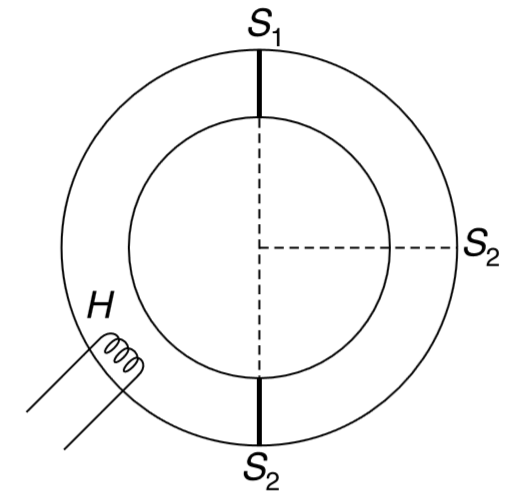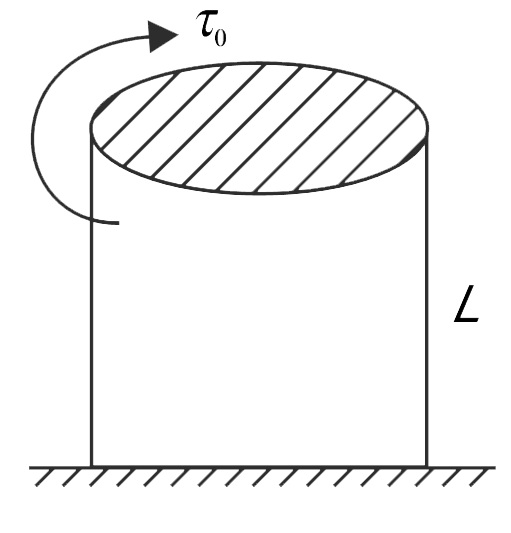A ring shaped tube has uniform cross sectional area and its entire volume is 2V0. The tube is well insulated from the surrounding. Inside the tube there is an adiabatic fixed wall S1 and another movable adiabatic partition S2. Initially, the movable partition is diametrically opposite to S1 and the two halves of the tube have equal amount of an ideal gas (g = 1.5) at same pressure P0. Now, a heater H is switched on which supplies heat slowly to one of the chambers. Heater is kept on till the partition S2 moves through the quarter of the circle. At this position the heater is switched off and the partition S2 remains in equilibrium. Neglect any friction as well as heat loss to the surrounding through the walls of the tube. Find the heat supplied by the heater to the gas.

The correct Answer is:4(2√2−1)P0V0
Step by step video, text & image solution for A ring shaped tube has uniform cross sectional area and its entire volume is 2V_(0). The tube is well insulated from the surrounding. Inside the tube there is an adiabatic fixed wall S_(1) and another movable adiabatic partition S_(2). Initially, the movable partition is diametrically opposite to S1 and the two halves of the tube have equal amount of an ideal gas (g = 1.5) at same pressure P_(0). Now, a heater H is switched on which supplies heat slowly to one of the chambers. Heater is kept on till the partition S_(2) moves through the quarter of the circle. At this position the heater is switched off and the partition S_(2) remains in equilibrium. Neglect any friction as well as heat loss to the surrounding through the walls of the tube. Find the heat supplied by the heater to the gas. by Physics experts to help you in doubts & scoring excellent marks in Class 11 exams.
Updated on:21/07/2023Topper's Solved these Questions
- FIRST LAW OF THERMODYNAMICSBOOK - ARIHANTCHAPTER - FIRST LAW OF THERMODYNAMICSEXERCISE - Level 3
6 Videos
- FIRST LAW OF THERMODYNAMICSBOOK - ARIHANTCHAPTER - FIRST LAW OF THERMODYNAMICSEXERCISE - Level 3
6 Videos
- ELASTICITYBOOK - ARIHANTCHAPTER - ELASTICITYEXERCISE - Level 3
1 Videos
- FLUIDSBOOK - ARIHANTCHAPTER - FLUIDSEXERCISE - All Questions
70 Videos
Similar Questions
An adiabatic cylinder of cross section A is fitted with a mass less conducting piston of thickness d and thermal conductivity K. Initially, a monatomic gas at temperature T0 and pressure P0 occupies a volume V0 in the cylinder. The atmospheric pressure is P0 and the atmospheric temperature is T1(>T0). Find
(a) the temperature of the gas as a function of time
(b) the height raised by the piston as a function of time.
Neglect friction and heat capacities of the container and the piston.
View SolutionAn adiabatic cylinder of cross section A is fitted with a mass less conducting piston of thickness d and thermal conductivity K. Initially, a monatomic gas at temperature T0 and pressure P0 occupies a volume V0 in the cylinder. The atmospheric pressure is P0 and the atmospheric temperature is T1(>T0). Find
(a) the temperature of the gas as a function of time
(b) the height raised by the piston as a function of time.
Neglect friction and heat capacities of the container and the piston.
View SolutionA metal cylinder of length L and radius R is fixed rigidly to ground with its axis vertical. A twisting torque τ0 is applied along the circumference at the top of the cylinder. This causes an angular twist of θ0 (rad) in the top surface. Calculate the shear modulus of elasticity (η) of the material of the cylinder.

View SolutionWe know that the atmospheric pressure on the surface of the earth is because of weight, of the air. The radius of the earth is 6400 km and atmospheric pressure on the sruface of earth is 1×105N/m2. Estimate the mass of the earth's atmosphere assuming that acceleration due to gravity remains constant at 10m/s2 over the entrie height of the atmospehre.
View Solutionshows a cylindrial tube of volume V with adiabatic walls containing an ideal gas. The internal energy of this ideal gas is given by 1.5nRT. The tube is divided into two equal parts by a fixed diathermic wall. Initially, the pressure and the tempreture are p1,T1 on the left and p2,T2 on the right. the system is left for sufficient time so that the tempreture becomes equal on the two sides. (a) how much work has been done by the gas on the left part ? (b) find the final pressures on the two sides. (c ) find the final equilibrium tempreture. (d) how much heat has flown from the gas on the right to the gas on the left ?

View SolutionIn the figure, the cross-sectional area of the smaller tube is a and that of the larger tube is 2a . A block of mass m is kept in the smaller tube having the base area that of the tube. The difference between water levels of the two tubes is
View SolutionAn adiabatic cylindrical tube is fitted with an adiabatic separator as shown in figure. Initial separator is in equilibrium and divides a tube in two equal parts. The seperator can be slide into the tube by an extermal mechanism. An ideal gas (gamma = 1.5) is injected in the two slides at equal pressure and temperature. Now separator is slid to a piston where it divides the tube in the ratio 7 :3 The ratio of the temperature in the two parts of the vessel is sqrt(n) : sqrt(7) find n .
View SolutionIn given figure, an adiabatic cylindrical tube of volume 2V0 is divided in two equal parts by a frictionless adiabatic separator. An ideal gas in left side of a tube having pressure P1 and temperature T1 where as in the right side having pressure P2 and temperature T2.Cp/Cv=γ is the same for both the gases. The separator is slid slowly and is released at a position where it can stay in equilibrium. Find (a) the final volumes of the two parts (b) the heat given to the gas in the left part and (c) the final common pressure of the gases,

View SolutionA cylindrical tube with adiabatic walls having volume 2V_(0) contains an ideal monoatomic gas as shown in figure. The tube is divided into two equal parts by a fixed super conducting wall. Initially, the pressure and the temperature are P_(0), T_(0) on the left and 2P_(0), 2T_(0) on the rigid. When system is left for sufficient amount of time the temperature on both sides becomes equal
View SolutionA cylindrical tube of cross sectional area A and length L is filled with an ideal gas. Temperature of the gas varies linearly from T0 at one end to2T0 at the other end. Calculate the number of mole of the gas in the tube assuming pressure to be uniform throughout equal to P.
View SolutionThere is a long vertical tube of radius r containing air at atmospheric pressure. A steel ball is held at the mouth of the tube and dropped. The ball has radius r and it just fits inside the tube. The tube wall is perfectly smooth and no air can leak from the tube as the ball falls inside it. The ball falls through half the length of the tube before coming to rest. Assume that wall of the tube is perfectly conducting and temperature of the air inside the tube remains constant. Density of steel is d and atmospheric pressure is P0 and take L>>r. Take air to be an ideal gas.
(a) Find the radius (r) of the tube.
(b) At what depth from the top of the tube the ball will be in equilibrium?

View Solution25∘C ताप पर एक विसर्ग नली में नाइट्रोजन गैस ली गई है। नली से इतनी गैस निकाल दी जाती है कि नली के अंदर गैस का दाब 0.02 mm हो जाता है। यदि विसर्ग नली का आयतन 2 L हो तो नली के अंदर शेष नाइट्रोजन के अणुओं की गणना करें।
(R=0.0821L - atm mol−1K−1)
View SolutionFig shows a cylindrical tube of volume V with adiabatic walls containing an ideal gas. The internal energy of this ideal gas is given by 1.5nRT. The tube is divided into two equal parts by a fixed diathermic wall. Initially, the pressure and the temperature are p1,T1 on the left and p2,T2 on the right. the system is left for sufficient time so that the temperature becomes equal on the two sides. (a) how much work has been done by the gas on the left part ? (b) find the final pressures on the two sides. (c ) find the final equilibrium temperature. (d) how much heat has flown from the gas on the right to the gas on the left ?

View SolutionWater is flowing streamline motion through a tube with its axis horizontal. Consider two points A and B in the tube at the same horizontal level. a) The pressure at A and B are equal for any shape of the tube. b) The pressure are never equal. c) The pressure are equal if the tube has nonuniform cross-section. d) The pressure may be equal even if the tube has a nonuniform cross-section.
View SolutionWater is flowing streamline motion through a tube with its axis horizontal. Consider two points A and B in the tube at the same horizontal level. a. The pressure at A and B are equal for any shape of the tube. b. The pressure are never equal. c. The pressure are equal if the tube has nonuniform cross section. d. The pressure may be equal even if the tube has a nonuniform cross section.
View Solution
